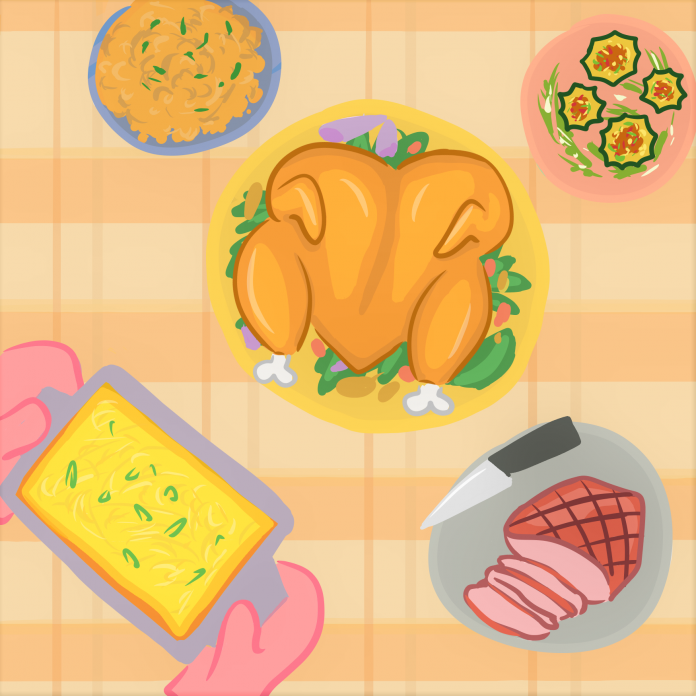Toss out the cotton cobwebs and surely-expired candy corn, it’s time for the best and most quintessentially American holiday of the year: Thanksgiving. Unlike any other commercial-cash-vacuum holiday, Thanksgiving is the one day a year where people have permission to stuff themselves with crumbly, savory and hearty dishes, with absolutely no judgment. I can think of no other holiday that dedicates an entire day to celebrating the good values of family, friendship, thankfulness and of course — food.
Taught in American school systems since elementary school, Thanksgiving is commonly conceptualized as a 1621 “feast” shared between the pilgrims of Plymouth Rock and the Wampanoag people. According to this narrative, the day was a celebration of the harvest, giving thanks for the benedictions of the past year and gathering grains for the harsh winter ahead. However, recent years have brought greater awareness to the fictitious nature of this tale and the way in which it overlooks the millions of indigenous peoples on Native lands that were slaughtered and oppressed and still are by colonial settlers. Though the holiday continues to be celebrated by many, it has evolved greatly over the years in accordance with changing social and cultural standards.
With many students across the United States trekking on home to celebrate the federal holiday with their family, niche cooking traditions undoubtedly sprout every autumn. Whether it be an accidental unskinned turkey that resembled a hairless cat or an over-spiced stuffing that turned out delicious, the fusion of cultures and coastal norms make for the most unique and cherished customs.
Across the world, the holiday has manifestations of the “harvest feast”, with countries such as Saint Lucia, Grenada and Liberia observing the holiday as a national celebration. The Canadians have their own version of the holiday, celebrated a month earlier on Oct. 10, while Brazil celebrates their “Dia de Acao de Gracas” on Nov. 4. While the American staples of mashed potatoes, mac and cheese, turkey, cranberry sauce and stuffing are common patterns in the Thanksgiving diet, each culture mixes in their own variations of dishes as well. In Canada, a glazed ham is often seen on the table, while the “farofa” — a sort of maize served as a side dish — is common in American-Brazilian celebrations, the traditional mashed potatoes often swapped for Mexican rice.
While my Thanksgiving experience has been “cultural” only in the sense that I venture down to my family in the South, the differences in what is served are quite evident from north-east to south. Traditional dishes such as hushpuppies, biscuits and cornbread stuffing incorporate the classic southern recipes into the meal. Especially in my New York hometown, substitutes such as the infamous “tofurkey” or vegan stuffing and gravy are becoming popularized to be inclusive to the vegan, vegetarian or restricted food’s communities.
At the College of William and Mary, students have found ways to fuse their many cultures into the Thanksgivings spent on and off campus. One of these cultural dishes is the stuffed acorn squash, commonly seen at the Thanksgiving table of Patrick Haney ’25.
“It’s this indigenous dish that we always make because my family is Mestizo,” Haney said. “And so it’s a squash type of dish with ground beef in the middle and some other spices.”
The indigenous dish itself is inspired by the Native American Three Sisters farming tradition’s crop of winter squash, corn and beans, combined into a native dish served as a homage to the original harvest.
Other students cook meals inspired by religious communities, such as the family of Rachel Sheldon ’24, who enjoys traditional Amish foods at their table.
“Amish tradition is ham loaf and ham balls,” Sheldon said. “We also have shoo-fly pie and chicken croquettes.”
Students on campus celebrate in whatever way they can before the actual break, whether it be dinners and events hosted by clubs or potlucks on the Sunken Garden. Interestingly, students in the College’s Joint Degree program with St Andrews University, are finding ways to celebrate the American holiday both at the College and abroad.
“I’m in the JDP program so I was there at that time last year,” Amanda Senk ’25 said. “And I did Thanksgiving with friends — British people — and they made me Shepards Pie, which is really bizarre. But it was so, so good. So I’m going to continue that tradition. Hopefully when I have Thanksgiving with my friends this year, we’ll actually try it.”
Typically, students on campus do makeshift Thanksgiving in apartments and dormitories alike. The idea of a Thanksgiving on campus, using whatever materials and goods available is a great excuse to gather a community of college friends and express gratitude before the chaos of going home.
“When I’m at college, we do ‘Friendsgiving’ with our friends, where we all kind of just bring our own dishes and everything,” Sheldon said. “So that’s a good way to still keep up that Thanksgiving vibe.”
In terms of easy meals for the remaining time of break after Thanksgiving, nothing is better than a loaded up leftover sandwich.
“The best thing is a Thanksgiving leftover sandwich,” Senk said. “So, you take your leftover turkey, leftover stuffing, cranberry sauce, veggies, whatever you have, add them on to some toasted bread with mayo. And it’s the best thing ever.”
This is the holiday to get creative, so seize the opportunity if you’re feeling inspired. I wish for everyone reading this to have a Thanksgiving full of delicious meals, fond memories and to finish it off with a fabulous postprandial nap.

